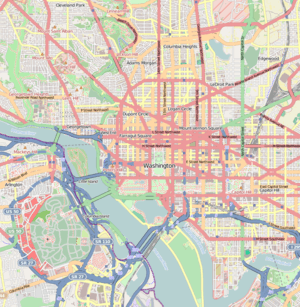Lincoln Temple United Church of Christ
|
Lincoln Industrial Mission- Lincoln Memorial Congregational Church | |
|
| |
 | |
| Location |
1701 11th St., NW Washington, D.C. |
|---|---|
| Coordinates | 38°54′47″N 77°1′36″W / 38.91306°N 77.02667°WCoordinates: 38°54′47″N 77°1′36″W / 38.91306°N 77.02667°W |
| Built | 1928 |
| Architect | Howard Wright Cutler |
| Part of | Greater U Street Historic District[1] (#93001129) |
| NRHP reference # | 95000163[2] |
| Added to NRHP | February 24, 1995 |
Lincoln Temple United Church of Christ was a congregation of the United Church of Christ located in the Shaw neighborhood in the Northwest Quadrant of Washington, D.C. The church building is a historic structure that was listed on the National Register of Historic Places in 1995. Its final service was held on September 30, 2018.[3]
History
The congregation can trace its roots back to the Lincoln Industrial Mission, which was founded as an educational and social aid mission. It was built on this site in 1868-1869.[4] Ten members of First Congregational Church established Lincoln Memorial Congregational Church in 1880 at the mission. The congregation merged with Park Temple Congregational Church in 1901 and it was given its present name.[5]
The American Negro Academy, the first major African American learned society in the United States, was formed by the Rev. Alexander Crummell and other intellectuals in 1897.[5] It held its inaugural address in the church. Notable musicians such as Jessye Norman, Marian Anderson and Roberta Flack have sung at the church.[6] Preachers and scholars such as Julian Bond and Jeremiah A. Wright, Jr. have spoken from its pulpit.
The congregation allowed people attending the 1963 March on Washington for Jobs and Freedom to camp out in the church's auditorium. The church distributed clothes and food during the riots that followed the assassination of Martin Luther King Jr.[3]
Final years
The Washington Post cites retirement of its longtime pastor, the Rev. Benjamin E. Lewis, in 1994 as the beginning of the church's decline. That coincided with demographic changes in the surrounding Shaw/Logan Circle neighborhoods, which went from 65 percent African-American population in 1990 to 29 percent in 2010.[3]
The congregation attempted to transform itself to appeal to the changed neighborhood, becoming an open and affirming church. It sponsored Saturday evening concerts with performances by the National Symphony and the Gay Men's Chorus, but concert-goers failed to return for Sunday services the next morning.[3]
Revised regulations that extended on-street parking restrictions to Sundays were also cited for the decline in church attendance.[3]
Architecture
The present church building was designed by Howard Wright Cutler in the Italian Romanesque Revival style. It was completed in 1928.[4] The building features a basilican plan with arched windows. The exterior has variegated brick and a gabled roof. The west façade of the church is dominated by a rose window and an arcaded portico. The portico features stone columns with foliate Byzantine capitals, corbelled frieze and a tile roof.[4]
References
- ↑ Trieschmann, Laura V.; Sellin, Anne; Callcott, Stephen (November 1998), National Register of Historic Places Registration Form: Greater U Street Historic District (PDF), retrieved March 31, 2015 .
- ↑ National Park Service (2009-03-13). "National Register Information System". National Register of Historic Places. National Park Service.
- 1 2 3 4 5 Brown, DeNeen L. (30 September 2018). "'The end of our journey': A historic black church closes its doors in a changing D.C." The Washington Post. Retrieved 1 October 2018.
- 1 2 3 "Lincoln Congregational Temple United Church of Christ". DC Preservation. Archived from the original on 2011-07-01. Retrieved 2011-11-17.
- 1 2 "Lincoln Memorial Congregational Church/American Negro Academy, African American Heritage Trail". Cultural Tourism DC. Archived from the original on 2012-05-12. Retrieved 2011-11-17.
- ↑ "History". Lincoln Temple United Church of Christ. Retrieved 2011-11-17.
External links
| Wikimedia Commons has media related to Lincoln Temple United Church of Christ. |